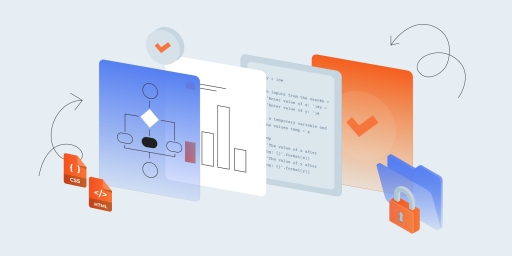You can never be sure about the quality of your in-development software unless you test it first. Conducting a thorough analysis of whether your software meets all the requirements, whether it is secure, responsive, complete, and easy to use is crucial to avoiding technical debt and making sure your software is well received after the release. And this is exactly what testers do for you.
Software testing is a process of investigation. A tester pushes your software through a great variety of tests to catch any hidden errors, unpredictable behavior, or functional inconsistencies. After every test, a tester files a detailed report that helps developers fix all the exposed issues, maintain the software error-free, and make sure it runs as intended.
There are many software testing approaches today, but the most popular in the field are black-box, white-box, and grey-box testing methods. While taking drastically different approaches, these methods effectively help developers keep their code clean and functionality in check. Let us help you understand what these methods are, what they are used for, and what is the difference between white box and black box testing, as well as find out their strengths and weaknesses.
Black-box testing
What’s peculiar about the black-box testing method is that the testers performing it have no knowledge of the internal structure and source code of the software they’re testing. And they don’t need to have any, neither do they need to have in-depth knowledge of programming languages or outstanding coding skills to perform the tests. This is mainly because the goal of this testing method is not to dig deep into the code, going through the software’s insides, but to interact with its user interface, test its functionality, and make sure that every input and output of the system meets the specified requirements. Therefore black-box testing can also be called functional testing or specification-based testing.
Such tests are performed from the point of view of end-users by an independent testing team in the course of STLC. A tester provides valid or invalid inputs and verifies the outputs against the expected outcomes. Every unexpected result and deviation is documented and reported to the development team, which helps them find and eliminate functional errors and inconsistencies early on.
This method is applicable at virtually every level of software testing: unit, integration, system, and acceptance. In unit testing, the black-box method is used to test the interface against the specifications given by the client. In integration testing, the aim is to find and eliminate errors in the interaction between integrated components of the interface. The black-box method can also be effectively applied in system testing to analyze the system’s compliance with the requirements, as well as in acceptance testing, where it can help validate the acceptability of a software product by testing it in various unexpected situations and circumstances.
Some of the most common black-box test design techniques include:
- Decision table testing comes in handy when debugging software based on the embedded if-then-else and switch-case statements in decision tables. It’s an effective way to find errors in what actions correspond to which conditions.
- Error guessing means that the tester designs test cases based on their intuition and experience in prior testing. They use it to determine what may cause software to fail or errors to appear.
- All-pairs testing is a technique used to test all the possible discrete combinations of each pair of input parameters. This really helps find common bugs that are usually hidden in interactions between pairs of parameters.
- The equivalence partitioning technique involves dividing input data into different smaller partitions, classes of equivalent data, from which test cases can be derived. The technique is used to build a test case that covers each partition at once, reducing the time needed for testing.
Black-box testing pros and cons
Black-box testing can really help identify any ambiguity, vagueness, and contradictions in functional specifications. It enables testers to assess and raise the quality of functionality implementation without directly interfering with the software’s large code segments. One of the key black box testing advantages is that black-box testing is entirely unbiased because the testing is carried out by an independent team, which separates the perspective of end-users from that of developers. Among the three methods, black-box testing features the quickest test case development, as it doesn’t require programming knowledge and can be easily performed by testers without a technical background.
Nevertheless, the method can be effectively applied to only testing small pieces of software. Testing large complex software thoroughly using this method would prove pretty inefficient and also be very time-consuming. In addition, this method requires clear and comprehensive specifications to be efficient. Otherwise, it will be extremely difficult to design test cases and the scenarios will provide very limited coverage.
White-box testing
As opposed to black-box testing that focuses on functionality, the goal of the white-box testing method is to perform the analysis of the internal structure of software and the logic behind it. White-box testing is therefore sometimes called structural testing or logic-driven testing. This method is very time-consuming and requires testers to have strong coding skills, full knowledge of the software they are testing, and access to all source code and architecture documents, otherwise, testers will not be able to design proper test cases. Hence, white-box testing is usually performed by professional developers who apply their expertise to get an internal perspective on the structure, figure out what exactly is going on in the source code, and fix what’s not working as expected. In addition to in-depth knowledge, the method also requires specialized tools for source code analysis and debugging.
Testers thoroughly study the code and other internal aspects of the given software, determine all the valid and invalid inputs, then verify the outputs against the expected outcomes. They check the statements and conditions, the code paths and dataflows to make sure there are no hidden errors or defect-prone elements.
White-box testing can be applied at the unit testing level, but it is mostly used for integration testing and regression testing today. The method enables testers to check paths within units for code defects and other issues that would prevent the software from working as intended. This is done before any integration with previously tested code happens, which reduces the risk of getting errors later in development. In integration testing, the method helps analyze interactions between different interfaces and subsystems. During regression testing, the white-box method can be very effectively applied through the usage of the white-box test cases recycled at the unit and integration testing levels.
Some of the most common white-box test design techniques include:
- Control flow testing is a structural testing strategy that uses the software’s control flows to test the logic of the code by executing input values and checking if they meet the required results.
- Data flow testing detects improper use of data values and data flow anomalies created by coding errors. The technique focuses on catching dodgy areas of codes so that more testing could be conducted to fix or eliminate these errors.
- There is not always one continuous flow of code. Sometimes the code branches out to perform particular functions covering different true/false conditions. The branch testing technique focuses on validating these branches and eliminating abnormalities.
Quality Assurance for a Financial Services Company
White-box testing pros and cons
Compared to black-box testing, the white-box method is like a precision strike that reveals errors in hidden code by removing the extra lines. Such in-depth knowledge of the source code makes dealing with side effects easier, which is very helpful. Another one of the many advantages of white box testing is that it enables traceability of every test on the source-code level where every future change can be easily captured in the newly added or modified tests. It exposes every inconspicuous bottleneck in the code and provides the dev team with maximum coverage and clear, concise feedback. This makes it easier for the dev team to reduce technical debt by optimizing and maintaining the quality of their code, especially since white-box testing can also be automated.
Automated or not, however, white-box testing is usually very time-consuming and complex. The approach requires testers to have top-notch programming skills and a thorough, code-level understanding of the software they are testing. It implies hiring top-notch engineers for the tests to be efficient, which makes the method way more expensive as well. When it comes to the time spent on testing and the skills required in the white box vs black box debate, white box testing is always the more demanding one.
Moreover, the test results are also strictly tied to the way the code was written. If the code tied to the same functionality is changed, it invalidates the previous assumptions, which can result in a failed test case with false positives. In addition, while the black-box method shines in functional testing, white-box testing will not be able to deliver, as it only focuses on the existing state of the software. This means it won’t be able to provide any feedback on the missing functionality, leaving many paths untested.
Grey-box testing
As you already know, black-box testing and white-box testing have different focus, showing significant advantages in one thing while being inefficient or having serious flaws in the other. Grey-box testing, in turn, gives the advantages of both black-box testing and white-box testing methods while neutralizing most of the flaws through the effective, balanced combining of the two. The grey-box method increases the coverage of testing techniques by focusing on all the layers of the software tested regardless of its complexity. While black-box testers make sure everything is fine with interfaces and functionality, and white-box testers dig into the internal structure and fix the source code of the software, grey-box testing deals with both at the same time in a non-intrusive manner.
The grey-box method targets complex systems with a straightforward black-box approach, which enables virtually anyone from developers to testers to end-users to perform the tests. To design test cases, however, an engineer requires partial knowledge of the internal structure, including documentation on data structures, architecture, as well as functional specifications of the software. The generated test cases are aimed at finding and eliminating defects in the structure and closing any gaps that would enable improper usage of the software.
Grey-box testing proves most useful at the integration testing level. It is well suited for testing web applications because they don’t have source code or binaries which makes them impossible to test using the white-box method. Grey-box testing can also be applied to business domain testing to confirm that the software meets the requirements.
Some of the most common grey-box test design techniques include:
- Matrix testing traces and maps user requirements to make sure everything is covered in the test cases. This makes it easy to identify any missing functionality. It’s like a status report that verifies the test coverage is complete.
- Regression testing is basically a software change impact analysis. It involves checking if the software works correctly after modifications. This technique is used to make sure there are no new bugs and nothing obstructs the existing functionality.
- The pattern testing technique analyses the previously encountered defects in the build, design, and architecture of the software being tested. This analysis is applied to find the root cause, specific reason behind a given defect and prevent it from happening again.
Grey-box testing pros and cons
The grey-box testing method offers combined benefits of black-box testing and white-box testing while dropping most of their disadvantages. The method is very non-intrusive as it is based on functional specifications, interfaces, and documentation that gives testers a peek into the software’s architecture rather than full access to the source code or binaries. This also means there is a clear line between testers and developers which makes this testing method completely unbiased. In addition, grey-box testing enables intelligent test authoring – exceptional test scenarios to analyze data types, communication protocols, exceptions, etc.
The method requires excellent project management, however, as the testing can be redundant if the developer has already run the related test cases. Due to limited knowledge of the internal structure of the software and no access to its source code, grey-box testing provides only partial test coverage with many code paths untested, which also makes it unsuitable for algorithm testing. Last but not least, it is very difficult to associate defect identification in distributed systems using the grey-box method.
We have described and compared the three main software testing methods companies use to ensure their products’ code quality and strict adherence to software requirements specification. These software testing methods help companies eliminate a lot of problems that could turn into huge technical debt in the long run. It’s also clear that the main difference between black box, white box and grey box testing is how much each of them have to do with the software code.
The big question is: which software testing method is the best? However, it would be wrong to say that one is significantly better than the other as every method serves different goals best. Black-box testing is using the requirements to derive external expectations and eliminate functional errors and inconsistencies. White-box testing investigates the source code to make sure there are no hidden errors or defect-prone elements. Finally, grey-box testing uses high-level data and functional specifications to catch defects and make sure the software meets the requirements.
If you need help choosing the right approach to testing for your project, contact us, and we will make sure no error slips through in your software solution!




